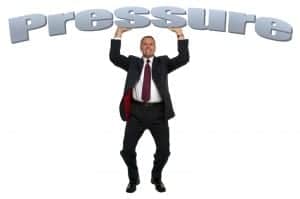
“He can’t handle the pressure.” “That’s a high-pressure job.” “Quit pressuring me!” Sometimes the pressures we experience are so real that it’s difficult to take a full breath, as if the pressure is squeezing our chest, constricting our movement. Here are some ways to change the situation so that pressure is diminished.
Physical Pressure
In physical terms, pressure is the force acting on a surface. If the surface is you, the forces are those that press in on you in areas of your life. There are distictions that can help us change our experience of pressure.
Imagine someone coming up behind you and putting an imaginary hand on your back. What makes the difference between experiencing it as pressure vs. support? We’ve probably all had a physical experience of the difference. When you ride in a car, your back touches the car seat. You don’t really notice any pressure coming from it. It’s just there as support.
However, when the car speeds up, you feel the pressure of the car seat on your back. Similarly, if someone is walking along with you with their hand on your back, you wouldn’t experience it as pressure. However, if they are pushing you to go faster, it probably will feel like pressure.
Pressured to Move Too Quickly
Now relate this to a non-physical example. Jane is an administrative assistant in the training department. She told her boss she might be interested in being a trainer herself someday. After that conversation, her boss started calling on her in their large departmental meetings to report on various topics. She felt put on the spot, and ill-equipped to speak in front of the group with no prior warning. She resented her manager for it.
Though Jane realized her boss’s intention was to support her in her career goals, he was pushing her too fast. Jane asked her boss to tell her in advance when he wanted her to speak. That was a level of growth that she felt she could handle, and she began to enjoy the opportunities.
Pressured to Go In a Different Direction
Another time you feel pressure from the car seat is when you go around a turn. To change directions requires a force, which creates pressure. Changing direction, or being pushed in a direction that is different from the direction you’re headed, can also affect you in your life.
John has been an exceptional designer for many years, and has moved up as high as he can go in the technical ranks. He feels pressured to move to management but he doesn’t want to. John loves all aspects of the technical sides of the job and isn’t resisting going “faster”. In John’s situation, the pressure comes from being pushed in a direction he doesn’t want to go. Communicating this to his manager can enable the manager to adjust and provide support instead of pressure.
Our Role in Creating the Pressure
Force, and thus pressure, occurs in the interaction of two objects. Therefore, another element is the role you play in an interaction. If you push back against the car seat, you will feel the pressure of the car seat pressing back on you. Similarly, if you push back when someone is supporting you, resisting their presence, that contributes to the feeling of being forced, pressured. If you don’t resist, the amount of pressure you experience will be a lot less.
When Jane resisted her boss’s attempts to push her into growth experiences, it increased her experience of pressure to an uncomfortable level. Once Jane let go and allowed herself to be pushed at a more comfortable pace, she was still moving more than she would have moved on her own.
If someone is supporting you, say thanks! If they’re pushing you too fast, or in a direction you don’t want to go, communicate with them. And check to see if your own resistance is actually creating pressure. When you stop resisting, the support and the motivating forces of others can aid you in getting you where you want to go.
